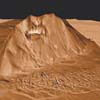 |
Washington DC (SPX) Jan 20, 2006 Scientists think they have established a link between an ancient collision in the main asteroid belt and a layer of dust particles deposited on Earth from space soon thereafter. The findings could help identify similar events in the geological record and provide more clues about the history of the solar system. "We managed to find a pretty good match," team member William F. Bottke, of the Southwest Research Institute in Boulder, Colo., told SpaceDaily.com . Using computer simulations, Bottke and colleagues retraced the orbits of a cluster of small asteroids and found that they seemed to converge into a single path about 8.2 million years ago. "Collisions produce fragments, and those fragments tend to cluster," he explained. "We've been looking for these associations and we've found families of smaller bodies." He said the data indicate that a 100-mile-wide asteroid named Veritas had smashed into another large object and was obliterated. The 8.2 million-year-old timeframe fell within the predictive abilities of the computer model, he added. Bottke said the team conducted the simulation after being contacted by Ken Farley of the California Institute of Technology in Pasadena. Farley had been studying the helium 3 content of ocean sediments. He found a layer in which concentrations of the isotope spiked by a factor of four compared with adjacent layers � a strong sign of interplanetary dust. He estimated the layer is 8.2 million years old. Bottke explained that the dust produced from asteroid collisions is enriched with helium 3 from the sun, differentiating it from terrestrial dust when it is captured by Earth's gravity, settles on the surface and is buried beneath the oceans. About 20,000 tons of such material accumulates on the planet's surface each year, but the accretion rate can surge after asteroid collisions. The sediment zone in question shows a sudden increase in dust containing excess helium 3, then a gradual drop over about 1.5 million years, until the dust composition returned to normal. Farley confirmed the finding by collecting sediment samples from two widely separated locations: one in the Indian Ocean and one in the Atlantic. He said the event is recorded clearly at both sites. "The helium 3 spike found in these sediments is the smoking gun that something quite dramatic happened to the interplanetary dust population 8.2 million years ago. It's one of the biggest dust events of the last 80 million years," Farley said. Bottke said the odds of tracking down similar events are much better now because of the significant progress in identifying asteroids. Over the past decade, efforts to locate and track potentially dangerous nearby orbiting bodies have produced the bonus of providing data on many more formerly undetected asteroids. "The number of known asteroids in the main belt has grown by at least a factor of 20 in the last 10 years," he said. The team's paper is published in the Jan. 19 issue of the journal Nature. Community Email This Article Comment On This Article Related Links SwRI Dept. of Space Studies Mars News and Information at MarsDaily.com Lunar Dreams and more
 Providence RI (SPX) Jan 20, 2006
Providence RI (SPX) Jan 20, 2006Snow is the source of glacial deposits found at the base of the majestic volcanoes and mountains dotting the mid-latitude and tropical regions of Mars. Based on an innovative blend of geological observations and climate modeling created by a team of American and French scientists, the finding appears in Science. |
|
| The content herein, unless otherwise known to be public domain, are Copyright 1995-2006 - SpaceDaily.AFP and UPI Wire Stories are copyright Agence France-Presse and United Press International. ESA PortalReports are copyright European Space Agency. All NASA sourced material is public domain. Additionalcopyrights may apply in whole or part to other bona fide parties. Advertising does not imply endorsement,agreement or approval of any opinions, statements or information provided by SpaceDaily on any Web page published or hosted by SpaceDaily. Privacy Statement |